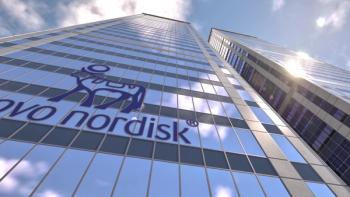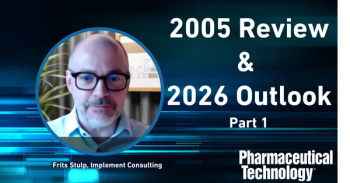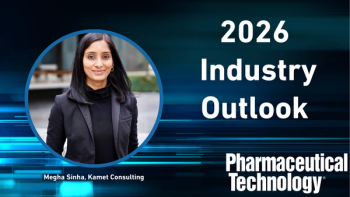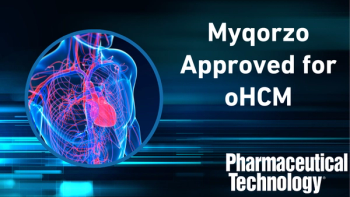
- Pharmaceutical Technology-07-02-2009
- Volume 33
- Issue 7
Outsourced Vaccine Development
The authors discuss how strategic outsourcing to contract manufacturing organizations that have technical and regulatory expertise can add further value during vaccine development.
The recent influenza A H1N1 / H5N1 outbreaks, as well as increased concern over biodefense, have dramatically raised public interest in vaccination to "front page" news. Together, these events are driving demand for rapid development of novel vaccines. In both the public psyche and around the board tables of large pharmaceutical companies, vaccines are undergoing somewhat of a renaissance.
In 2007, vaccines demonstrated significant market growth, outperforming most other sectors of the industry, predominantly due to the success of Merck's (Whitehouse Station, NJ) Gardasil and continued strong performance of Prevnar from Wyeth (Madison, WI). This growth and a market of approximately $16.3 billion in 2007 (with projections of a $100 billion market by 2024 based on a similar compound annual growth rate)(1) has attracted the attention of companies not traditionally associated with vaccines. The vaccine industry is at present an oligopoly, dominated by major players Merck, sanofi-aventis/pasteur (Paris), GlaxoSmithKline (GSK, London), Novartis (Basel,) and Wyeth (Pfizer). However, the high performing potential of vaccines now represents an attractive prospect for other large pharma companies with concerns over diminishing returns through their traditional pipelines.
Images and figure courtesy of Eden Biodesign, Inc.
In addition to corporate organizations, the cost effectiveness of vaccination rather than treatment is widely recognized by international health authorities. Further sources of funding from philanthropic organizations such as the Bill and Melinda Gates Foundation have boosted the development and availability of pediatric vaccines in developing countries. Likewise, there continues to be high levels of biodefense funding for vaccine research and development (2).
Each of the above factors represents a driver for growth in vaccine development, which perhaps explains why there are more vaccine products (prophylactic and therapeutic) in development than any other class of biological medicine (see Figure 1)(3). This growth will only be sustained through innovation and strategic development, and although the biopharmaceutical industry has come a long way since the earliest days of vaccine manufacturing, the challenges remain fairly constant: What is the most reliable and cost effective manufacturing method? How does one ensure that the starting materials and final product are, respectively, consistently safe and of high quality? Who can manufacture the amount of vaccine needed for clinical trials and, eventually, commercial production?
Figure 1: Biotechnology medicines in development by product category.
In terms of both biochemical composition and methods of production, vaccines represent the most diverse class of biopharmaceuticals. Unlike monoclonal antibodies (mAbs) that are now produced and analyzed using relatively generic platform processes and methods, the complexity and variety of vaccines generate many challenges during process design and development. In this paper, the authors review the technological advances that will expedite vaccine development as well as add value to it. They also outline points to consider when choosing a contract manufacturing organization (CMO) for vaccine development projects.
Adding value during vaccine development
Expression technologies. As for all biopharmaceuticals, there are key value-adding stages during vaccine development. However, as vaccines are probably the most disparate of all biological medicines, both in terms of biochemical composition and the methods of production, there are currently only a limited number of platform manufacturing methods applicable to distinct vaccines. Likewise, there is not a single expression system suitable for numerous vaccine candidates, as they range from relatively simple polypeptides to entire cells.
The criteria when choosing an expression system are the same as for any other biopharmaceutical—it is essential that the system produce a product of consistent safety and quality. It is also necessary to ensure that the yield of the production method is fully-optimized, as cost-of-goods for vaccines are critically important, particularly for those medicines intended for supply to developing nations.
The adoption of novel expression systems has to be carefully considered. Although there are benefits in applying innovation to shorten development times and be first to market, the vaccine industry is traditionally relatively conservative. This is because the medicines are typically administered to healthy patients, and there is a resulting strong emphasis on product safety. In addition, the complex nature of many vaccines minimizes the available options for risk-reduction through extensive product characterization.
As vaccines are typically administered in fewer and smaller doses than are therapeutic drugs, market supply may consist of grams rather than kilograms of material per annum, diminishing the net requirement for large-scale production. The drive for large-scale production involving high-titer expression systems has, therefore, been less for vaccine manufacture than for other biological molecules such as monoclonal antibodies. With all of these considerations, there has been reluctance in the vaccine industry to adopt novel expression systems, but rather a preference for working with well established systems of a known and accepted safety profile.
There are examples of economic and regulatory influences, however, that are encouraging the adoption of new expression technologies for vaccine development. A high profile example is the move from eggs to cell culture in the production of the influenza vaccine (see Table 1). There is likely to be further adoption of new expression systems, especially those with associated benefits for reducing overall development times.
Table 1: Drivers to move from eggs to cell culture when manufacturing influenza vaccine.
There are very few expression systems that are specifically targeted toward vaccines, although there are technologies used in protein expression that are particularly adaptable to vaccine manufacturing. These include the PER.C6 cell line, and the associated AdVac/Virosome technology, available from Crucell/DSM (Leiden, The Netherlands), and the avian-derived cell lines from Vivalis (EBx, Nantes, France) and ProBioGen (Berlin, Germany). Another expression technology with potential benefits is the Pfēnex Expression Technology from Dow (Midland, MI), which has been applied to generate high levels of vaccine antigens. Insect cells also represent an alternative system for vaccine production, with examples including production of antigen for the Provenge cellular vaccine (Dendreon, Seattle, WA) and Ceravix (GSK). Protein Sciences Corporation (Meriden, CT). has developed a patented baculovirus protein expression system (BEVS) for production of proteins and vaccines in variant Sf9 cells.
Rational drug design. There are few examples of engineered vaccines, probably because the technology is relatively immature and the approaches of protein engineering are not easily applied to traditionally complex vaccines. There is, however, potential application of protein engineering as subunit recombinant vaccines are further developed (4). One of the main objectives in the rational design of conventional biotherapeutics is to minimize immunogenicity, either through humanization, PEGylation, or by reducing protein aggregation. The opposite is true for vaccines, however, where protein design may be applied to increase the antigenicity of the molecule.
Process development and advances in vaccine production. As described, vaccines are complex and diverse biomolecules ranging from recombinant subunit antigens to live organisms. Correspondingly, therefore, a range of production technologies are required to manufacture sufficient quantities of these products, including the use of eggs, cell factories, roller bottles, shake/tissue culture flasks, and bioreactors. This range of production methods can be problematic, as each method requires specific capital expenditure, specialized development approaches, and operator expertise. As a result, there is a growing trend to lower the number of production platforms by implementing manufacture in suspension culture bioreactors wherever possible. For vaccines manufactured in mammalian-cell culture, it is necessary to establish well-characterized expression permissive cell lines that have been adapted to grow in suspension culture, and (where appropriate) in a serum-free medium. An example of this is the emergence of suspension HEK293 cultures for the production of adenovirus viral vectors, where the development of chemically defined and serum-free formulations has been influential in increasing titers and generating fully scalable processes (5). Similarly, microbial systems are being optimized for the manufacture of vaccines, especially those in which co-expression of two or more proteins is beneficial to provide multivalency.
There has also been significant investment in the provision of disposable bioreactor systems for vaccine manufacturing, as they are particularly useful in multiproduct environments, where they reduce the requirement for cleaning-validation activities (6). They can also be rapidly deployed in emergency situations. Although the use of disposable systems (stirred tank or rocking platform) is gaining momentum for vaccines manufactured in mammalian cell culture, further development is necessary to provide the mass transfer required for microbial cultures.
Vaccine purification, in particular purification of whole-cell vaccines or those comprised of complex macromolecules, has traditionally been relatively inefficient and technically challenging. For example, production of viruses and virus-like particles (VLPs) has commonly involved a primary purification step by density-gradient centrifugation, a labor-intensive process that is not readily scalable. An alternative strategy is to apply column chromatography, which until recently has been confined mainly for use as a polishing step during the production of viruses and VLPs. The binding capacity of conventional porous chromatography resins for typically large molecules in recombinant vaccines during primary capture is relatively low because of steric restriction to the active binding channels. This capacity can be increased when using membranes or monolithic columns, as these have a wider pores and channels, and thus offer a more accessible active chemistry than the porous beads within packed beds (7). Membranes and monoliths can also be operated at high flow rates, resulting in smaller columns and shorter cycle times. These combined benefits are making chromatographic purification of certain vaccines an increasingly viable option.
Characterization and formulation. For many complex vaccines, the true proof of principle can only be gained by clinical testing, which means that in preclinical development, the product features that influence efficacy may be poorly defined. It is important, however, to elucidate the physicochemical features of the vaccine as far as practicable. As vaccines are traditionally relatively complex, detailed characterization has necessitated the development of novel analytical methods such as those based upon spectroscopy and mass spectrometry (8). These developments, in turn, have provided opportunities to design and evaluate vaccine manufacturing processes with greater consistency.
Designing formulations that enhance stability upon storage and maintain or optimize the subsequent immune response is of critical importance during vaccine development. Vaccines, perhaps more than any other class of biopharmaceutical, require storage across a wide range of temperatures, especially when administered in developing nations or in military environments. Likewise, the complexity of vaccines often causes them to be relatively unstable in comparison with other pharmaceutical products that have a low turn over and frequently require a long shelf life.
A more established way of achieving stability is through lyophilization. If it is not possible to maintain stability in a liquid formulation, then removing the solvent via freeze- or spray-drying represents another way to minimize product degradation. For this reason, many vaccines are lyophilized before storage and reconstituted in water for injection (WFI) immediately before administration. Vaccine delivery can be further improved by using technologies that involve controlled product release from microspheres. Spray-drying technology is particularly suited to vaccines since alum-based adjuvants (see below) are preserved during spray drying, and the resulting powder can be combined stoichiometrically during the preparation of multi-valent vaccines.
Many vaccines are formulated with adjuvants, which help modulate and stimulate the immune response (9). These compounds bind to the vaccine and aid retention at the site of injection or delivery to the lymph nodes. As a result, the release of the antigens to the surrounding tissues is slowed, inducing a stronger immune response than would be generated by the vaccine alone. The predominant adjuvants are "alum" based, containing a mixture of aluminum salts. However, there are novel adjuvants under investigation that can provide benefits over alum such as the technology developed by Antigenics (Lexington, MA), QS-21, an adjuvant derived from tree bark (10). The uptake of new adjuvants may be restricted, as they themselves will require testing and regulatory approval, similar to the vaccine itself.
Outsourcing vaccine development and manufacture
As described, the complexity of vaccines creates a unique set of challenges during process and product development. Within a portfolio of vaccines, there may be a wide range of products, each requiring different production technologies—viral, microbial, and mammalian. Very few CMOs have the expertise and facilities required for all these technologies, meaning that vaccine developers must manage multiple vendors, relationships, and locations to progress development of their vaccine portfolio.
Companies outsourcing mAb production enjoy a reasonable mutual confidence that a small-scale in-house developed process can be transferred to a variety of CMOs for scale-up. In contrast, vaccine developers will typically need to engage with CMOs earlier in development to avoid the possibility of transfer issues at a later stage. In addition to specific manufacturing capabilities, it is necessary to find a CMO that can provide expertise in a range of ancillary functions such as characterization and formulation, as described above. Outsourced fill and finish of vaccines can also be challenging, as very few contract service providers have the capability to formulate and fill live bacterial or viral vaccines.
With the above considerations in mind, many vaccine developers have chosen to establish their own facilities. We argue, however, that this can represent considerable commercial risk and a deployment of capital that might otherwise be used to expand product development portfolios. In many cases, well-managed outsourcing of vaccine development provides manufacturers with opportunities to accelerate speed to market, mitigates their risk, and provides task-specific technical and regulatory expertise that is otherwise expensive to hire and retain. Effective outsourced vaccine development is achievable as long as the right partners are chosen and the relationship is well managed. The following are a few recommendations to consider when choosing and working with a CMO during vaccine development (11):
Develop a request for proposal (RFP) that includes:
- Comprehensive information about your product and any existing process (e.g., molecular characteristics, cell line to be used, analytical methods used for testing)
- Information about your project, including estimated time line, production scale required, how much material will need to be delivered, stage of product life cycle (i.e., preclinical, Phase III, etc)
- A delivery date for the proposal
We recommend that you contact at least three CMOs to provide proposals to compare capabilities, capacity, quality systems, project management, and pricing. It will be necessary to establish Confidentiality Disclosure Agreements (CDAs) to continue to share more detailed information.
Shortlist to CMOs that have:
- Experience with product classes that are the same as or similar to the composition of your vaccine.
- A successful track record in guiding biopharmaceuticals through all phases of clinical development and an associated in-depth understanding of the technical and global regulatory challenges to be faced.
- A compliant and validated facility, with appropriate equipment at the scale needed to complete the project in a timely manner and at a reasonable price.
- Available facility space in a timeframe that supports your project time lines. A flexible production schedule is beneficial, especially during early development when time lines are not easy to predict
- A scale of operation that will grow with your product, either in-house or through chosen third parties throughout the supply chain.
- Enabling technology that is appropriate for your product and an established network of qualified third-party vendors who can support activities (e.g., execution of advanced analytical methods, fill/finish) that will contribute to the overall project.
- Quality systems/regulatory accreditation in place (as appropriate for the phase of development and manufacturing).
- An established project management system, with experienced project management staff who can work with scientists and quality experts to manage deliverables, communication between the CMO staff and the client and well-defined project milestones
- A clear and transparent intellectual property position and mechanisms to ensure confidentiality as well as data security.
- Formalized technology transfer/risk assessment processes.
It is very important to understand the CMO well and, where possible, to meet the people who could potentially perform your development project before you start your project. This provides an opportunity to understand not only the technical capabilities, but also the corporate culture, company organization, and the company's approach to clients. Following a quality systems and facility audit, you will be in a position to choose a CMO that best fits your criteria, timeline and budget.
Once the CMO is chosen. The most successful outsourcing relationships are ones in which the project goals are clear from the outset, and open communication is maintained throughout. During initial start-up meetings, it is important to establish and agree upon the deliverables and success factors of both parties. These meetings also provide an opportunity to build a good rapport with the members of your project team and solidify a good working relationship from day one.
- Establish a full project scope-of-work, inducing key deliverables and milestones
- Determine the baseline fee schedule and timeline and agree to terms and conditions
- Establish a suitable quality agreement
- Agree on method(s) of communication (email, teleconference, face-to-face meetings) and frequency; determine points of contact for these communications
- Determine preferred format of development reports/manufacturing instructions etc, or review CMOs standard templates to ensure they are suitable for your requirements
- Confirm project kick-off date, and once all documents are in place, start the project.
Progression and completion of the project:
- Request experimental designs that explain how the deliverables in the scope of work will be achieved.
- Where required, transfer your process/analytical methods to the CMO. We recommend a "person in plant" arrangement wherever possible, as this allows any product-specific nuances to be readily communicated and facilitates rapid feedback, decision-making, and document sign-off.
- Communication throughout the project should be based upon the agreed formula, with any "out of the ordinary" occurrences or questions addressed as soon as possible.
- Request routine checks of the project progression against the baselines; generally the Client and the CMO's project manager will manage this activity.
- Delivery of development reports or CGMP product, including supporting documentation that can be applied to the regulatory filing (e.g., IND, NDA, BLA, MAA), depending on the stage of the project and product type.
Conclusions
Demand for the development of processes to manufacture novel and established vaccines is currently very high. The authors have explored how new technologies and experienced CMOs are expediting and adding value during vaccine development.
Although the vaccine industry has been hesitant to adopt enabling technologies in the past, particularly novel expression systems, economic, and regulatory influences are encouraging vaccine developers to embrace cutting-edge scientific alternatives and to realize some of the operational and regulatory benefits enjoyed by mAb developers.
The requirement for specialized manufacturing capabilities and regulatory experience are reasons that companies have traditionally been reluctant to outsource vaccine development, preferring rather to establish their own facilities. We argue that this represents considerable commercial risk and uses capital that might otherwise be used to expand product portfolios. We argue that vaccine developers should consider well-managed outsourced vaccine development.
Effective outsourced vaccine development can be achieved as long as the right partners are chosen and the relationship is well managed. To take full advantage of new technological advances and innovative strategic approaches now creating opportunities, vaccine developers must carefully evaluate CMOs and select only those that can provide expertise across a range of ancillary functions. Ideally, the CMO will be able to manage a wide range of products and different technologies such as viral, microbial, and mammalian production—and will have the manufacturing facilities required to manage a diverse vaccine portfolio.
In addition to having appropriate technical expertise and facilities, however, the complexities of vaccine development when compared with many therapeutic biologics demand that your selected CMO is well experienced in vaccine development and can therefore offer the necessary vaccine-specific regulatory support and guidance. Working with a carefully chosen CMO and maintaining a strong relationship from bench to market provides opportunities to accelerate vaccine development, mitigates risk, and provides the technical and regulatory expertise that is otherwise expensive to obtain.
Phil Ball, PhD, is a technical director, and Maria Lusk is director of client management, both at Eden BioDesign,
References
1. Kalorama Information,
2. C. Franco, "Billions for Biodefense: Federal Agency Biodefense Funding, FY2008-FY2009," Biosecurity and Bioterrorism: Biodefense Strategy, Practice, and Science, 6 (2), page 131 (2008).
3. PhRMA, "Report on Biotechnology Medicines in Development", 2008,
4. K.J. Morrow, Jr., "Revamping and Reengineering Existing Technology Can Increase Protein Yield and Efficacy," Gen. Engineer. and Biotechnol. News, 27 (5) 50–54 (2007).
5. Y. Durocher et al., "Scalable serum-free Production of Recombinant adeno-associated Virus Type 2 by Transfection of 293 Suspension cells, Journ. of Virolog. Meth., 144, p. 32 (2007).
6. H.R.G. Clarke, and B.J. Compton, "Comparing Mammalian Expression Systems The First Rate-Limiting Step in Making Products for Clinical Testing," supplement to BioProcess Internat., 6 (11) 24–32 (2008).
7. P. Gagnon, "Monoliths Emerge as Key Purification Methodology," Gen. Engineer. and Biotechnol. News, 28 (14) (2008),
8. C. H. Arnaud, "Analyzing Vaccines," Chem. & Engineer. News, 84 (14), P. 52 (2006).
9. C. Scott, "Formulation Development, Making the Medicine," supplement to BioProcess Internat., 42 (3) 42–56, March 2006.
10. A. Sjolander, J.C. Cox, and I.G. Barr, "ISCOMs: An Adjuvant with Multiple Functions," Jour. of Leukocyte Biol., 64, 713–723 (1998).
11. S. Crossman and J. Lawson, "Considerations for Choosing a CMO," Contract Pharm., 10 (2008),
Articles in this issue
over 16 years ago
Pharmaceutical Technology, July 2009 Issue (PDF)over 16 years ago
Using NIR to Move Bioprocessing into a PAT Frameworkover 16 years ago
East Meets West in Contract Biologics Manufacturingover 16 years ago
Down the Track: Different Speeds with Multiple APIsover 16 years ago
Integration of PAT in Biopharmaceutical Research: A Case Studyover 16 years ago
A Tale of Two Techniquesover 16 years ago
Manufacturers Face New Risk-Management Requirementsover 16 years ago
Can Industry Learn to Share?over 16 years ago
Next-Generation Facilities for Monoclonal Antibody Productionover 16 years ago
The Biopharmaceutical Manufacturing SurveyNewsletter
Get the essential updates shaping the future of pharma manufacturing and compliance—subscribe today to Pharmaceutical Technology and never miss a breakthrough.




